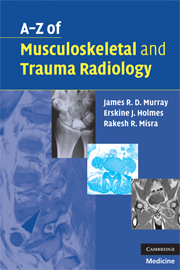Book contents
- Frontmatter
- Contents
- Acknowledgements
- Preface
- List of abbreviations
- Section I Musculoskeletal radiology
- Section II Trauma radiology
- ATLS – Advanced Trauma Life Support
- Acetabular fractures
- Aortic rupture
- Cervical spine injury
- Flail chest
- Haemothorax
- Open fractures
- Pelvic fracture
- Peri-physeal injury
- Pneumothorax
- Rib/sternal fracture
- Skull fracture
- Thoraco-lumbar spine fractures
- Acromioclavicular joint injury
- Carpal dislocation and instability
- Clavicular fractures
- Elbow injuries and distal humeral fractures
- Hand injuries – general principles
- Hand injuries – specific examples
- Thumb metacarpal fractures
- Humerus fracture – proximal fractures
- Humerus fracture – shaft fractures
- Humerus fracture – supracondylar fractures – paediatric
- Radius fracture – head of radius fractures
- Radius fracture – shaft fractures
- Galeazzi fracture dislocation
- Radius fracture – distal radial fractures
- Related wrist fractures
- Scaphoid fracture
- Scapular fracture
- Shoulder dislocation
- Ulna fracture – proximal and olecranon fractures
- Ulna fracture – shaft fractures
- Monteggia fracture dislocation
- Accessory ossicles of the foot
- Ankle fractures
- Bone bruising
- Calcaneal (Os calcis) fractures
- Femoral neck fracture
- Femoral shaft fracture
- Femoral supracondylar fracture
- Hip dislocation – traumatic
- Knee soft-tissue injury
- Metatarsal fractures – commonly fifth MT base
- Patella fracture
- Tibial-plateau fracture
- Tibial-shaft fractures
- Tibial-plafond (Pilon) fractures
- Talus fractures/dislocations
Hip dislocation – traumatic
from Section II - Trauma radiology
Published online by Cambridge University Press: 22 August 2009
- Frontmatter
- Contents
- Acknowledgements
- Preface
- List of abbreviations
- Section I Musculoskeletal radiology
- Section II Trauma radiology
- ATLS – Advanced Trauma Life Support
- Acetabular fractures
- Aortic rupture
- Cervical spine injury
- Flail chest
- Haemothorax
- Open fractures
- Pelvic fracture
- Peri-physeal injury
- Pneumothorax
- Rib/sternal fracture
- Skull fracture
- Thoraco-lumbar spine fractures
- Acromioclavicular joint injury
- Carpal dislocation and instability
- Clavicular fractures
- Elbow injuries and distal humeral fractures
- Hand injuries – general principles
- Hand injuries – specific examples
- Thumb metacarpal fractures
- Humerus fracture – proximal fractures
- Humerus fracture – shaft fractures
- Humerus fracture – supracondylar fractures – paediatric
- Radius fracture – head of radius fractures
- Radius fracture – shaft fractures
- Galeazzi fracture dislocation
- Radius fracture – distal radial fractures
- Related wrist fractures
- Scaphoid fracture
- Scapular fracture
- Shoulder dislocation
- Ulna fracture – proximal and olecranon fractures
- Ulna fracture – shaft fractures
- Monteggia fracture dislocation
- Accessory ossicles of the foot
- Ankle fractures
- Bone bruising
- Calcaneal (Os calcis) fractures
- Femoral neck fracture
- Femoral shaft fracture
- Femoral supracondylar fracture
- Hip dislocation – traumatic
- Knee soft-tissue injury
- Metatarsal fractures – commonly fifth MT base
- Patella fracture
- Tibial-plateau fracture
- Tibial-shaft fractures
- Tibial-plafond (Pilon) fractures
- Talus fractures/dislocations
Summary
Characteristics
Mechanism of injury usually involves massive force transmitted along the femoral shaft, e.g. a dashboard injury in a road-traffic accident.
Posterior dislocation (80%) tends to occur with the hip flexed and adducted at time of impact. With abduction, anterior dislocation can occur.
Central dislocation occurs with medial displacement of the femoral head through or partially through a fragmented acetabulum.
Often associated with other injuries such as a patellar fracture, PCL injury or posterior acetabular-wall fracture.
Clinical features
Posterior dislocations – leg is flexed, adducted and internally rotated – unless an associated femoral neck or shaft fracture mask the deformity.
Pain tends to be excruciating.
With an acetabular (e.g. posterior wall) fracture, spontaneous reduction possible.
Sciatic nerve injuries are common – up to 20% – test preferentially the peroneal (test foot eversion) rather than tibial branch (foot plantar flexion) of the sciatic nerve.
Radiological features
Abnormality usually obvious on the AP view. Lateral view recommended in all cases to aid in determining direction of dislocation and associated fractures.
With posterior dislocations the femoral head appears smaller than the unaffected side on the AP view and conversely with anterior it appears larger.
Look for the lesser trochanter – overlies the femoral shaft in posterior dislocation (due to internal rotation), whereas it is seen in profile in anterior (due to external rotation).
Look for acetabular involvement as this affects likelihood of sciatic-nerve damage, stability and long-term functional outcome.
Always assess the pelvic ring fully as associated fractures/disruption are common – see ‘Pelvic and acetabular fractures’.
Management
ABCs, assess soft tissues, neurovascular status, reduce and immobilise.
Early reduction is the definitive treatment. Complete muscle relaxation is desirable and thus reduction under general anaesthetic with screening is optimal to decrease femoral head trauma.
[…]
- Type
- Chapter
- Information
- A-Z of Musculoskeletal and Trauma Radiology , pp. 312 - 315Publisher: Cambridge University PressPrint publication year: 2008



